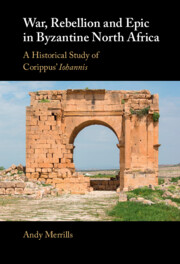Book contents
- War, Rebellion and Epic in Byzantine North Africa
- War, Rebellion and Epic in Byzantine North Africa
- Copyright page
- Dedication
- Contents
- Maps
- Preface
- A Note on Abbreviations, Translations and Maps
- Chapter 1 ‘I Sing of Things That Are Not Unknown’
- Chapter 2 Prelude to a War
- Chapter 3 Past and Future in the Iohannis
- Chapter 4 Corippus and the Moorish World
- Chapter 5 ‘For Every Blade Was Red’
- Chapter 6 Christianity and Paganism in the Iohannis
- Conclusions
- Bibliography
- Index
Chapter 4 - Corippus and the Moorish World
Published online by Cambridge University Press: 12 October 2023
- War, Rebellion and Epic in Byzantine North Africa
- War, Rebellion and Epic in Byzantine North Africa
- Copyright page
- Dedication
- Contents
- Maps
- Preface
- A Note on Abbreviations, Translations and Maps
- Chapter 1 ‘I Sing of Things That Are Not Unknown’
- Chapter 2 Prelude to a War
- Chapter 3 Past and Future in the Iohannis
- Chapter 4 Corippus and the Moorish World
- Chapter 5 ‘For Every Blade Was Red’
- Chapter 6 Christianity and Paganism in the Iohannis
- Conclusions
- Bibliography
- Index
Summary
This chapter examines the different lenses through which Corippus represented the Moorish world. It looks first at the many terms the poet used to refer to all of the ‘Moorish’ groups within North Africa – ally or enemy alike. It then considers the specific ethnonyms within the Iohannis and addresses their value for our understanding of North Africa in this period. It notes that Corippus’ accounts of ‘Laguatan’ identity (an ethnonym preserved in many forms in the Iohannis, but unique to the poem) may well indicate forms of affiliation that were much more fluid than has previously been acknowledged, and incorporated a range of different groups, regardless of their origins.
The chapter closes with a discussion of the ‘catalogue of tribes’ in Iohannis Book II, which has been central to much modern scholarship. It argues that this catalogue was intended to evoke the final triumphal ceremony which marked the conclusion of John’s campaigns in 548. This has an important narrative function, but also reveals the cognitive assumptions which underpinned imperial views of the Moorish world from Carthage. This was not an ordered ‘map’ of tessellating tribal groups, but was instead an image of a diverse – but ultimately subjugated – world.
- Type
- Chapter
- Information
- War, Rebellion and Epic in Byzantine North AfricaA Historical Study of Corippus' <i>Iohannis</i>, pp. 128 - 171Publisher: Cambridge University PressPrint publication year: 2023

